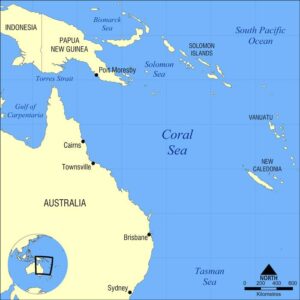Table of contents
Coral Sea Australia
The Coral Sea contains numerous islands and reefs, including the world’s largest reef, the world heritage listed Great Barrier Reef.
This massive body of water is located east of the Great Barrier Reef, with Papua New Guinea to the north, the Tasman Front to the south and the west Pacific islands (Solomons, Vanuatu and New Caledonia) to the east. Indeed the Coral Sea takes its name from coral formations on the Great Barrier Reef, the largest known reef system in the world.
Coral Sea Map

Coral Sea Animals
This area is home to some of the most exquisite coral reefs in the world and contains wonderful biodiversity! Hence the sea is home to an immense range of underwater life that can be found nowhere else on the globe.
It is home to over 2,000 species of fish, nearly 800 species of coral, almost 600 species of algae and more than 400 species of crustaceans. You might encounter turtles, sea snakes, barracuda, sharks, manta rays and dugongs while exploring the wonders of the spectacular marine life.
Coral Sea Islands
The Sea Islands Territory is made up of the islands situated in an area of 780,000 square kilometres, extending from the outer edge of the Great Barrier Reef. The coral and sand islands are quite small with some grass and low vegetation cover.
Only Willis Island is inhabited by Meteorological Bureau staff. Unmanned weather stations, beacons and a lighthouse are located on several other islands and reefs.
The Coral Sea contains 49 habitats (from tropical islands to small cays) many of which are important for seabirds and turtles.
How Deep is the Coral Sea?
The Coral Sea varies in depth, with an average depth of 2,396m. However, it reaches a maximum depth of 9,140m.
Sea Currents
These currents are the continuous, directed movement of seawater. Indeed currents are generated by a number of forces acting upon the water, including wind, breaking waves, and temperature and salinity differences.
Depth contours, shoreline configurations, and interactions with other currents influence a current’s direction and strength. Indeed ocean currents are primarily horizontal water movements.
Consequently, these ocean currents are abbreviated as follows: EAC, east Australian current; NQC, north Queensland current; NCJ, north Caledonian jet; SCJ, south Caledonian jet; SFJ, south Fiji jet; SVJ, south Vanuatu jet; NVJ, north Vanuatu jet; SECC, south equatorial counter-current; NGCC, New Guinea coastal current.
Ocean currents are crucial, not just to weather and climate, they also facilitate the dispersal of marine organisms from one reef to another
Thank you for reading about the coral sea.

